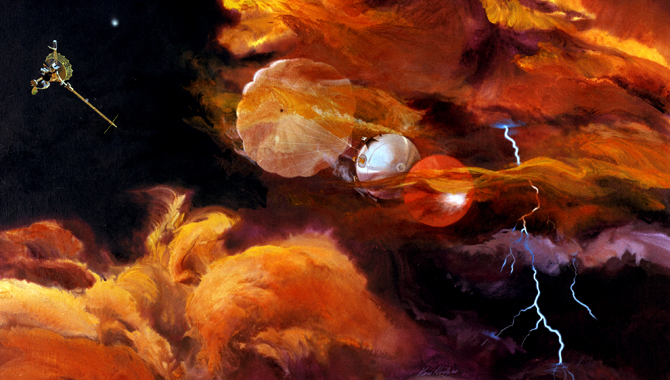
On January 26, 2014, the Hubble Space Telescope Imaging Spectrograph (STIS) instrument captured this image suggesting plumes of water vapor emerging from the southern region of Jupiter’s satellite Europa. An image of Europa, based on data from the Galileo and Voyager missions, is superimposed over the Hubble image.
Image Credits: NASA/ESA/W. Sparks (STScI)/USGS Astrogeology Science Center
Images suggesting the presence of icy plumes erupting from the surface of Europa offer hope that it may be easier than expected to search for signs of life on Jupiter’s moon.
Far beneath Europa’s hard, icy shell, scientists believe there is a large subsurface ocean of liquid salty water. This feature is particularly intriguing because it implies that the Jovian satellite could harbor the potential for life. To investigate Europa’s habitability, NASA intends to launch the Europa Multiple Flyby Mission in the 2020s. But even if the findings from that mission are positive, researchers will have to overcome another critical barrier: the miles of ice that lie between the moon’s surface and the ocean beneath.
Thanks to recent findings from a Hubble Space Telescope-based observational campaign, this barrier now appears potentially less daunting. Led by William Sparks, an astronomer with the Space Telescope Science Institute in Baltimore, MD, a team has acquired new images that indicate the presence of water vapor plumes protruding periodically from the surface of the moon.
“If there are plumes emerging from Europa, it is significant because it means we may be able to explore that ocean of Europa for organic chemicals or even signs of life without having to drill through unknown miles of ice,” said Sparks.
To detect the plumes, the team employed a technique typically used to study exoplanet atmospheres. “As an exoplanet—that is, a planet orbiting a star other than the sun—passes in front of its host star, some of the light of the star passes through the atmosphere of the planet and is influenced by it. So we can infer what the properties of the exoplanet atmosphere are. Here, we are taking images, but the principle is similar,” said Sparks.
The images were captured in the far ultraviolent wavelength as Europa passed in front of Jupiter on 10 separate occasions. Potential plumes appear to jut out, primarily from the moon’s southern region, in three of the images. The research team used Hubble’s Space Telescope Imaging Spectrograph (STIS) instrument to detect evidence of the plumes.
This is not the first time observers have identified potential plumes on Europa. In 2012, a team led by Lorenz Roth of the Southwest Research Institute (SWRI) in San Antonio, TX, also uncovered evidence of plumes using the STIS. “One of the reasons this new finding is so intriguing is because it’s a different technique that complements the Roth team. The Roth team used spectroscopy, so they really could discern evidence of dissociated water molecules, hydrogen and oxygen. The Sparks team discovered through imaging evidence of plume activity visually. So these are different approaches, but they complement one another, and they seem to both be evidence, independent evidence, of plume activity on Europa,” said Jennifer Wiseman, senior Hubble project scientist at Goddard Space Flight Center (GSFC).
Despite the existence of two studies using the Hubble Space Telescope that indicate the presence of plumes on Europa, Sparks cautioned, “I do want to stress that the observations are at the limit of what Hubble can do. We’re not aware of any instrumental artifacts that could cause these features. They are statistically significant. But we remain cautious because we are working at a difficult wavelength for Hubble. We do not claim to have proven the existence of plumes but rather to have contributed evidence that such activity may be present.”
Currently, only one object in the solar system is known to feature water vapor eruptions. Saturn’s moon Enceladus, which contains a south polar sea, emits plumes from its southern region. These were verified by the Cassini spacecraft in 2005 as it flew through the plumes and ingested the ejected material, which provided extensive information about Enceladus’s subsurface sea. NASA hopes the upcoming Europa mission will do the same for Jupiter’s moon.
Curt Niebur, Europa Multiple Flyby Mission project scientist, said, “We have nine instruments on the Europa flyby mission. Each one of those instruments is a very powerful plume hunter in addition to its primary science investigation. So with those nine instruments, we feel we…have the ability to aggressively investigate these plumes.”
The mission’s instruments span the wavelength range from ultraviolet through visible to the infrared, and are equipped to observe in the thermal range as well. “So they could actually see the hot spots on the surface, the vents themselves, that are going to be much warmer than the surrounding ice. And this is where the plumes would actually originate from,” he added. If the plumes exist, compositional instruments will obtain samples of the material for analysis.
For now, the Sparks team will continue to examine the images of Europa it obtained using the Hubble Space Telescope. In 2018, NASA’s James Webb Space Telescope will liftoff, adding infrared capabilities to observations of Europa. Eventually, the Europa flyby mission will deepen understanding of the putative plumes as well as the potential habitability of the Jovian satellite.
“For a long time, humanity’s been wondering whether there is life beyond Earth,” said Paul Hertz, director of the Astrophysics Division at NASA Headquarters. “And we’re lucky to live in an era where we can address questions like that scientifically using all the tools available to us, including the Hubble Space Telescope. On Earth, life is found wherever there is energy, water, and nutrients. So we have a special interest in any place that might possess those characteristics. And Europa might be such a place.”
Watch a video about Europa’s subsurface ocean and the moon’s potential habitability.
Read an APPEL News article about the science instruments selected for the Europa flyby mission.









